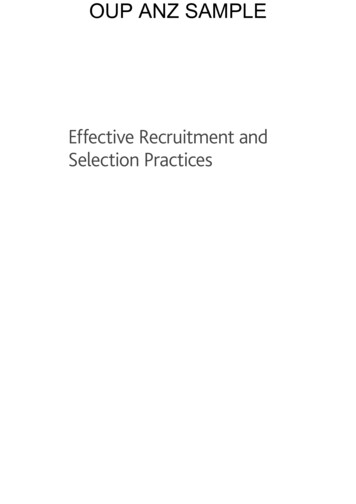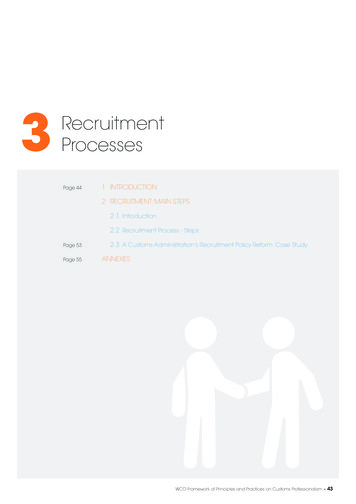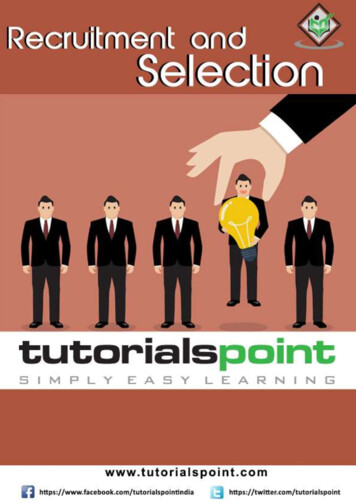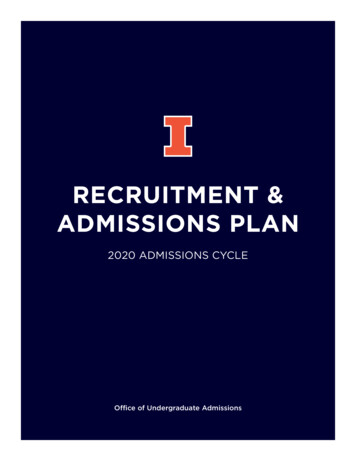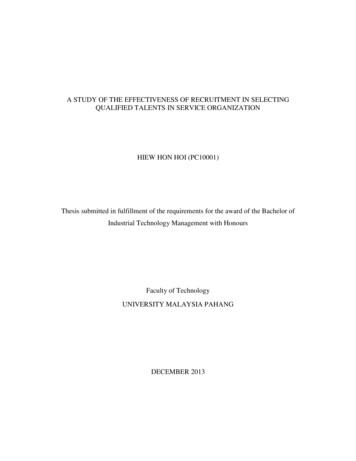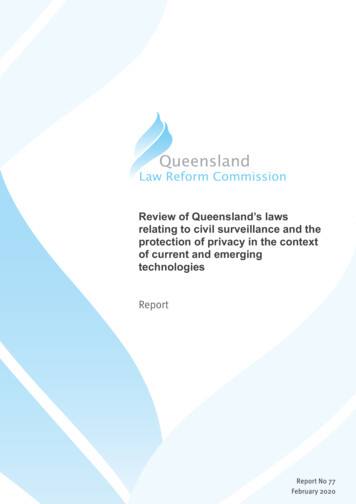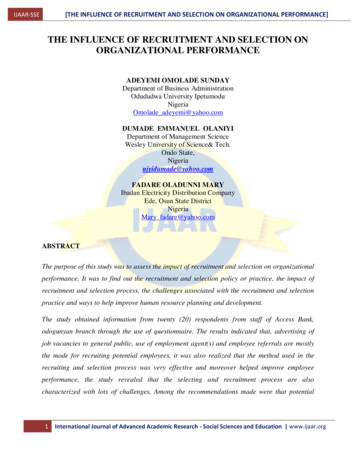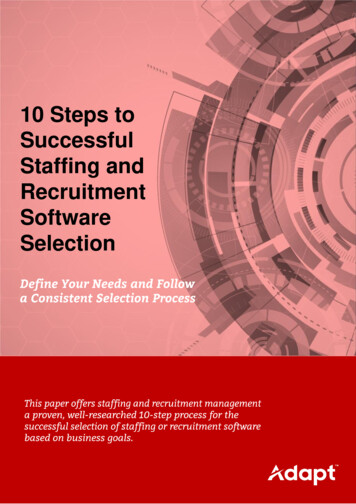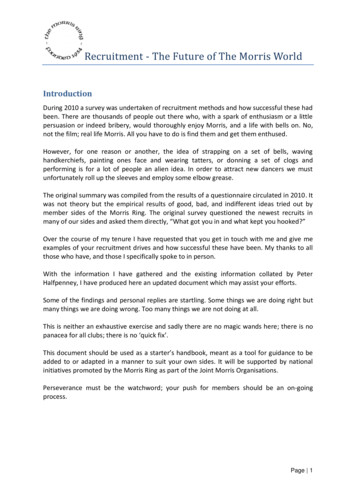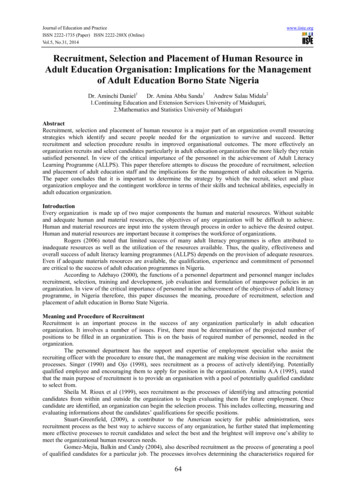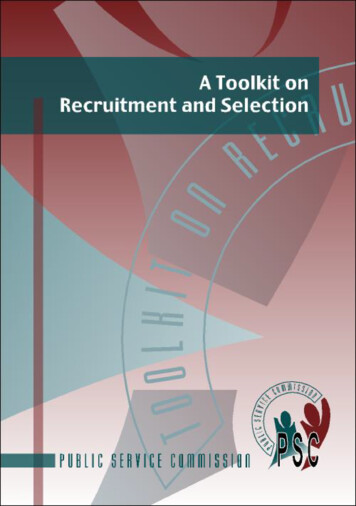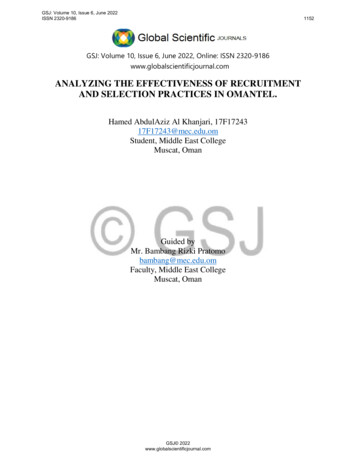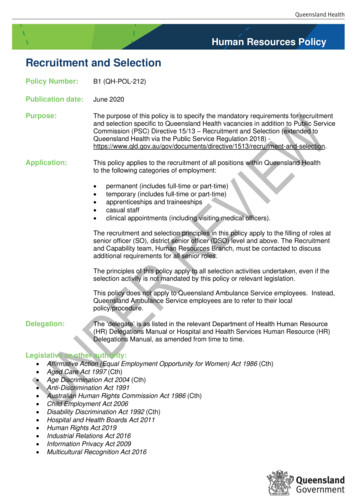
Transcription
Human Resources PolicyRecruitment and SelectionPolicy Number:B1 (QH-POL-212)Publication date:June 2020Purpose:The purpose of this policy is to specify the mandatory requirements for recruitmentand selection specific to Queensland Health vacancies in addition to Public ServiceCommission (PSC) Directive 15/13 – Recruitment and Selection (extended toQueensland Health via the Public Service Regulation 2018) 3/recruitment-and-selection.Application:This policy applies to the recruitment of all positions within Queensland Healthto the following categories of employment: permanent (includes full-time or part-time)temporary (includes full-time or part-time)apprenticeships and traineeshipscasual staffclinical appointments (including visiting medical officers).The recruitment and selection principles in this policy apply to the filling of roles atsenior officer (SO), district senior officer (DSO) level and above. The Recruitmentand Capability team, Human Resources Branch, must be contacted to discussadditional requirements for all senior roles.The principles of this policy apply to all selection activities undertaken, even if theselection activity is not mandated by this policy or relevant legislation.This policy does not apply to Queensland Ambulance Service employees. Instead,Queensland Ambulance Service employees are to refer to their localpolicy/procedure.Delegation:The ‘delegate’ is as listed in the relevant Department of Health Human Resource(HR) Delegations Manual or Hospital and Health Services Human Resource (HR)Delegations Manual, as amended from time to time.Legislative or other authority: Affirmative Action (Equal Employment Opportunity for Women) Act 1986 (Cth)Aged Care Act 1997 (Cth)Age Discrimination Act 2004 (Cth)Anti-Discrimination Act 1991Australian Human Rights Commission Act 1986 (Cth)Child Employment Act 2006Disability Discrimination Act 1992 (Cth)Hospital and Health Boards Act 2011Human Rights Act 2019Industrial Relations Act 2016Information Privacy Act 2009Multicultural Recognition Act 2016
Public Service Act 2008Public Service Regulation 2018Racial Discrimination Act 1975 (Cth)Right to Information Act 2009Sex Discrimination Act 1984 (Cth)Workers’ Compensation and Rehabilitation Act 2003Working with Children (Risk Management and Screening) Act 2000Nurses and Midwives (Queensland Health and Department of Education) Certified Agreement(EB10) 2018Medical Officers' (Queensland Health) Certified Agreement (No.5) 2019 (MOCA5)Queensland Public Health Sector Certified Agreement (No. 9) 2016 (EB9)Queensland Health Building, Engineering and Maintenance Services Certified Agreement (No. 6)2016Health Practitioners and Dental Officers (Queensland Health) Certified Agreement (No.2) 2016Queensland Government Standing Offer Arrangement (SOA) No. 200PSC Directive03/17 – AppealsPSC Directive 01/17 – Conversion of casual employees to permanent employmentPSC Directive 04/18 – Early Retirement, Redundancy and RetrenchmentPSC Directive 7/11 – Employment ScreeningPSC Directive 15/13 – Recruitment and SelectionPSC Directive 17/16 – Supporting employees affected by workplace changePSC Directive 08/17 – Temporary employmentPSC (IR) Directive 10/16 – Transfer within and between Classification Levels and SystemsPSC Directive 05/12 – Workforce Establishment Management ProgramCode of Conduct for the Queensland Public ServiceHealth Executive Services Terms and Conditions of Employment DocumentRelated policy or documents: PSC Lobbyist Disclosure PolicyCommission Chief Executive Guideline 02/13: Evidence of attribute – Aboriginal and/or Torres StraitIslander identified rolesAboriginal and Torres Strait Islander Health Workforce Strategic Framework 2016-2027Queensland Health Workforce Diversity and Inclusion Strategy 2017-2022Nursing and midwifery classification evaluation methodology HR Policy B7 (QH-POL-179)Health Professionals Registration: Medical officers, nurses, midwives and other health professionalsHR Policy B14 (QH-POL-147)Job Evaluation – Roles covered by the classification and remuneration system HR Policy B29 (QHPOL-159)Appointment of Permanent Relief Staff to Non-Relieving Positions - Administrative Stream HR PolicyB31 (QH-POL-102)Employees requiring placement HR Policy B36 (QH-POL-237)Employment screening HR Policy B40 (QH-POL-122)Secondment HR Policy B42 (QH-POL-224)Citizenship, Residency, Visas and Immigration HR Policy B46 (QH-POL-250)Conversion of temporary employees to permanent status HR Policy B52 (QH-POL-119)Health practitioners – Job evaluation HR Policy B68 (QH-POL-194)Flexible working arrangements HR Policy C5 (QH-POL-242)Determining Salary Levels Upon Appointment HR Policy C59 (QH-POL-245)Transfer and Appointment Expenses HR Policy D4 (QH-POL-245)Recruitment and selection HR Policy B1Human Resources BranchChief Human Resources OfficerJune 2020Page 2 of 30PRINTED COPIES ARE UNCONTROLLED.
Workplace conduct and ethics HR Policy E1 (QH-POL-113)Conflicts of interest guideline (QH-GDL-113-1)Anti-discrimination and vilification HR Policy E2 (QH-POL-101)Employee Complaints HR Policy E12 (QH-POL-140)Diversity and inclusion HR Policy G2 (QH-POL-132)Reasonable Adjustment HR Policy G3 (QH-POL-210)Separation of Employment HR Policy H1 (QH-POL-227)Indemnity for Queensland Health’s Medical Practitioners HR Policy I2 (QH-POL-153)Queensland Health Implementation Standard for Vaccination of Healthcare Workers(QH-IMP-321-9)Guideline: Disclosure of pre-existing conditions under the Workers Compensation and RehabilitationAct 2003 (QH-GDL-212-1)Guideline for Transfers and Movements in Queensland HealthVisa Entitlement Verification Online (VEVO) guidelineDeveloping Role Descriptions GuidelineRole description templateIdentified (lawful discrimination) role templatePolicy subject:1Recruitment and selection in Queensland Health. 5Part I – Workforce planning and job design . 52Workforce planning and job design . 52.1Identified (lawful discrimination) roles . 62.2Role evaluation methodology . 6Part II – Filling vacancies . 73Employees affected by workplace change . 74Transfer/movement at level . 75Secondments . 86Staff interchange/work arrangements . 87Direct appointments . 87.1Direct appointment of a temporary or casual employee, apprentice or trainee to a permanent entrylevel role7.2. 8Direct appointment of a temporary employee to tenured status at level to a permanent non entrylevel role. 87.3Direct appointment to roles at a higher level . 97.4Temporary and casual conversion to permanent status . 98Advertising8.1Advertising vacancies . 108.2Exemptions from advertising . 108.3Recurring vacancies . 11. 10Recruitment and selection HR Policy B1Human Resources BranchChief Human Resources OfficerJune 2020Page 3 of 30PRINTED COPIES ARE UNCONTROLLED.
8.4Administrative, operational, professional and technical streams . 128.4.1Advertising of permanent base grade positions. 128.4.2Advertising of non-base grade positions . 128.4.3Order of merit . 12Part III – Merit and panel formation. 129Merit10Panel responsibilities . 1210.1Selection panel . 1210.2Declarations – Potential conflict of interest/prior knowledge of applicant . 1310.2.1Prior knowledge of applicant . 1310.2.2Conflict of interest . 1410.3Role of chair . 1410.4Moderation10.5Diversity and inclusion . 1510.6Unconscious bias. 1510.7Reasonable adjustment . 15Part IV – Selection. 12. 15. 1511Selection strategy . 1511.1Selection strategy . 1511.2Assessment process . 1611.3Assessment of applicants submitted by a recruitment agency . 1612Referee checking . 1612.1Selection report. 1712.2Paypoint recommendation . 17Part V - Pre-appointment . 1713Pre-appointment . 1713.1Delegate responsibilities . 1713.2Early retirement (ER), voluntary separation program (VSP) and voluntary redundancy (VR) statuschecks. 1813.3Proof of identity . 1813.4Employment screening . 1913.5Curriculum vitae (CV)/resume . 2013.6Vaccine preventable diseases (VPD) . 2013.7Employment of school-aged or young children . 23Part VI – Appointment . 2314Appointment . 23Recruitment and selection HR Policy B1Human Resources BranchChief Human Resources OfficerJune 2020Page 4 of 30PRINTED COPIES ARE UNCONTROLLED.
14.1Verbal appointment notification . 2314.2Other notifications . 2314.3Appointment offer . 2414.4Work location . 24Part VIII – Post appointment . 2515Post appointment . 2515.1Selection feedback . 2515.2Documentation and confidentiality . 25Definitions: . 25History: . 28Attachment One1Identified (lawful discrimination) rolesRecruitment and selection in Queensland HealthPSC Directive 15/13 – Recruitment and Selection specifies the minimum requirements applying to therecruitment and selection of public service employees and health service employees.The appropriate delegate is responsible for authorising and approving decisions related to recruitmentactivities and appointments. A delegate can elect to be on the selection panel, however delegationsfor all decisions related to the recruitment will shift up to the delegate’s line manager (the ‘one up’rule).This policy sets out additional requirements and standard processes specific to Queensland Healthand must be read in conjunction with PSC Directive 15/13 – Recruitment and Selection 3/recruitment-and-selection.Part I – Workforce planning and job design2Workforce planning and job designThe PSC Directive 05/12 – Workforce Establishment Management Framework sets out the principlethat service wide workforce management strategies align with government priorities. This supports theGovernment’s commitment to a public service that delivers effective, efficient and responsive servicesto the community.To ensure that a role description accurately reflects the role within the organisational structure, roledescriptions are to be reviewed: when the role key accountabilities/duties changewhen a vacancy occurs in that position (prior to advertising)when organisational change significantly impacts on the role.Organisational cultural fit and/or specific personal qualities are to be articulated in the role descriptionto ensure merit is transparently and appropriately assessed. When designing a job or reviewing a roledescription, managers should consider how role design embeds and encourages workforce flexibility,diversity and inclusion. Once reviewed, and if warranted, e.g. the role changes significantly, a roleevaluation should then occur.Recruitment and selection HR Policy B1Human Resources BranchChief Human Resources OfficerJune 2020Page 5 of 30PRINTED COPIES ARE UNCONTROLLED.
2.1 Identified (lawful discrimination) rolesMandatory requirements of a role can include attributes required for appointment to an identifiedposition. An identified role is a position in which it is lawful to discriminate in favour of a personpossessing one or more of the attributes set out in section 7 of the Anti-Discrimination Act 1991 forthe purpose contained in sections 25, 104 and 105 of that Act. Refer to Attachment One of this policyfor the requirements and processes for identified positions within Queensland Health.2.2 Role evaluation methodologyAll classification streams in Queensland Health are supported by a job or work level evaluationmethodology specified by the relevant award, industrial agreement, or HR policy. The following tablesummarises the methodologies used by each major classification stream.ClassificationStreamJob/work level evaluation methodologyAdministrative,Operational,Technical andProfessionalJob Evaluation Management System (JEMS) is the standard generic roleevaluation methodology used in the Queensland Government.For more information on the JEMS process, refer to job evaluation rolescovered by the Job Evaluation – Roles covered by the classification andremuneration system HR Policy B29.Operational stream – additional informationThe Operational Services Manual identifies the various methods to be usedfor supervisory, managerial and other specialist roles in the operationalstream. Generic level statements for most operational positions are containedwithin the Operational Services Manual. Newly created role descriptionsbelow OO5 that are not defined in the Operational Services ManualDetermination C are to be submitted via the Public Hospitals OversightCommittee (PHOC) Secretariat for approval by PHOC.Professional and technical streams – additional informationLevels 1 and 2 of the professional and technical streams are not required tobe evaluated because, by definition, these levels exist for the purpose offulfilling prerequisite education and training prior to appointment to the level ofpractising professional or technical officer at level 2.Building andengineeringClassification levels are determined by competency levels contained underthe relevant Queensland Health Building, Engineering and MaintenanceServices Certified Agreement (No.6) 2016.Dentists andDental SpecialistsRefer generic level statements outlined in Schedule 4 of the HealthPractitioners and Dental Officers (Queensland Health) Award – State 2015.Health practitionerHealth practitioner classification levels 1 to 8 are evaluated through worklevel statements contained within the Health Practitioners and Dental Officers(Queensland Health) Certified Agreement (No. 2) 2016. Refer to Healthpractitioners – Job evaluation HR Policy B68.MedicalGeneral medical position classification definitions are contained within theMedical Officers (Queensland Health) Award – State 2015 and the MedicalOfficers' (Queensland Health) Certified Agreement (No.5) 2018 (MOCA5).Recruitment and selection HR Policy B1Human Resources BranchChief Human Resources OfficerJune 2020Page 6 of 30PRINTED COPIES ARE UNCONTROLLED.
Nursing andmidwiferyThe Nursing and midwifery classification evaluation methodology HR PolicyB7 sets out the process to support the evaluation and re-evaluation ofnursing and midwifery positions. Nursing and midwifery role evaluation isbased on Schedule 2 of the Nurses and Midwives (Queensland Health)Award – State 2015, which contains generic level statements of theaccountability/responsibility of nursing and midwifery roles from Grade 1 toGrade 13, across five domains of practice.SeniorOfficer/DistrictSenior OfficerSenior ExecutiveService/HealthExecutive ServiceSenior officer and executive service roles must be evaluated by Mercer PtyLtd or Queensland Shared Services (Shared Service Agency) unless thespecific use of these authorised service providers is waived by the relevantdelegate for the purposes of JEMS evaluation.In instances where the specific use of Mercer Pty Ltd or Queensland SharedServices (Shared Service Agency) is waived by the relevant delegate, seniorofficer and executive service roles must be JEMS evaluated in accordancewith the other provisions of the Job Evaluation – Roles covered by theclassification and remuneration system HR Policy B29.Part II – Filling vacancies3Employees affected by workplace changePrior to advertising any permanent vacancies or temporary vacancies of greater than 12 months (withthe exception of clinical and/or frontline roles), employees affected by workplace change must beconsidered for placement in accordance with PSC Directive 17/16 – Supporting employees affectedby workplace change.Clinical and/or front-line roles are to be checked in the Vacancy Advertising Database for EffectiveRecruitment (VADER) and the panel chair will be alerted to any matches in the same way as nonfrontline roles.Under the NDIS workforce strategy (2015–2019), additional vacancies, including specified frontlineroles of at least 12 months duration, have been identified under Section 12.1 of PSC Directive 17/16.Impacted locations will be progressively advised of the vacancies that must be referred forconsideration of displaced employees as the strategy is implemented.Refer to the Employees requiring placement HR Policy B36 for further information regardingemployees affected by workplace change.4Transfer/movement at levelTransfer/movement at level can be considered prior to advertising or after the vacancy has beenadvertised, e.g. when considering the pool of applicants. Transfer/movement at level is atmanagement discretion and may be considered on a case-by-case basis. Transfer/movement at levelcan proceed even if there are registered employees affected by workplace change.Transfer/movement at level requires the employee being transferred to be permanent at that level, ormeet eligibility for transfer across classification streams, but not necessarily the same employmentstatus e.g. a full-time employee may seek transfer/movement at level to a part-time role.Recruitment and selection HR Policy B1Human Resources BranchChief Human Resources OfficerJune 2020Page 7 of 30PRINTED COPIES ARE UNCONTROLLED.
Refer to Transfers and movements in Queensland Health Guideline for further information.5SecondmentsRefer to the Secondments HR Policy B42 for further information.6Staff interchange/work arrangementsFormal staff interchange and work arrangements exist between Queensland Governmentdepartments/agencies and Federal Government/local authorities when employees in one sector maybe engaged on temporary assignments in another sector.Staff interchange arrangements require an interchange agreement to outline work arrangements andensure the continuity of indemnity and entitlements for Queensland Health employees. Refer tosections 183 and 184 of the Public Service Act 2008 (extended to health service employees throughthe Public Service Regulation 2018).7Direct appointmentsApplications for all categories of direct appointments are to be considered on a case-by-case basis. Atthe discretion of the appropriate delegate, direct appointment may be approved in accordance withsections 7.1 to 7.3 of this policy or to positions that have been exempt from advertising in accordancewith section 8.2 of this policy.In all situations of direct appointment, consideration is to be given to improving and retaining theworkforce diversity of the immediate team.This section does not apply to a health practitioner eight (HP8) classification level appointment. Allappointments to the HP8 classification level will be by advertisement and merit selection process.7.1 Direct appointment of a temporary or casual employee, apprentice or trainee to apermanent entry-level roleThe appropriate delegate may direct appoint a temporary or casual employee, apprentice or trainee toa permanent entry-level role if all of the following requirements are met: The applicant has been appointed on a temporary or casual basis via a merit process (i.e.minimum two selection techniques, employees affected by workplace change checkundertaken).The employee has been assessed as having demonstrated performance of a sufficiently highstandard that advertising the role would be unlikely to yield a superior candidate.The date of appointment under this provision is to be the date of approval of the appointment by theappropriate delegate.7.2 Direct appointment of a temporary employee to tenured status at level to apermanent non entry-level roleThe appropriate delegate may convert a temporary employee to tenured status at level if all of thefollowing requirements are met:Recruitment and selection HR Policy B1Human Resources BranchChief Human Resources OfficerJune 2020Page 8 of 30PRINTED COPIES ARE UNCONTROLLED.
The temporary role must have been advertised according to the provisions of sections 9.1 to 9.5of PSC Directive 15/13 – Recruitment and Selection and the temporary employee demonstratedtheir merit in the open merit process.The temporary employee must have undertaken the duties of the role for a continuous period ofnot less than one year.The temporary employee must be assessed as having demonstrated performance of asufficiently high standard that advertising the role would be unlikely to yield a superiorcandidate.The suitability of the agency’s own registered and unregistered employees has first beenconsidered in accordance with provisions contained in the PSC directive and policy relating toemployees affected by workplace change.7.3 Direct appointment to roles at a higher levelThis section does not apply to senior executive roles, senior officer roles, or appointments at the HP8classification level.The appropriate delegate may, without advertising, direct appoint an employee to a role at a higherclassification level, where the occupant has been seconded to or temporarily employed in the role, orthe role has been reclassified.In both cases above, the employee must: have undertaken the role in question for a total of not less than one of the preceding two yearsandbe assessed as having demonstrated performance of a sufficiently high standard thatadvertising the role would be unlikely to yield a superior candidate.In relation to direct appointment following secondment to, or temporary employment in, a role at ahigher classification level, the temporary role must have been advertised according to the provisionsof sections 9.1 to 9.5 of PSC Directive 15/13 – Recruitment and Selection. The occupant of the role isrequired to have demonstrated their merit in an open merit process.In relation to direct appointment to roles which have been reclassified, all of the followingrequirements must be met: The employee must be the substantive occupant.Reclassification must not be higher than one classification level above the employee’ssubstantive classification level.An employee who has been appointed to a higher classification level via direct appointment is noteligible for further appointment under the provisions of that section if the role in question is againevaluated at a higher classification level. An open merit selection process is to be undertaken.7.4 Temporary and casual conversion to permanent statusAn eligible temporary employee may be converted to permanent status in accordance with the PSCDirective 08/17 – Temporary employment and Conversion of temporary employees to permanentstatus HR Policy B52.An eligible casual employee may request to be converted to permanent status in accordance withthe PSC Directive 01/17 – Conversion of casual employees to permanent employment.Recruitment and selection HR Policy B1Human Resources BranchChief Human Resources OfficerJune 2020Page 9 of 30PRINTED COPIES ARE UNCONTROLLED.
These conversion processes are separate to direct appointment, however, remain an option formanagers to fill vacant roles.8Advertising8.1 Advertising vacanciesThe minimum vacancy advertising requirements are outlined in PSC Directive 15/13 – Recruitmentand Selection.In addition to the options outlined in the PSC Directive, consideration is to be given to advertising in away that will attract a diverse pool of applicants.The following additional advertising requirements may be considered:Multi-disciplinary positionsMulti-disciplinary positio
Operational stream - additional information The Operational Services Manual identifies the various methods to be used for supervisory, managerial and other specialist roles in the operational stream. Generic level statements for most operational positions are contained within the Operational Services Manual. Newly created role descriptions
